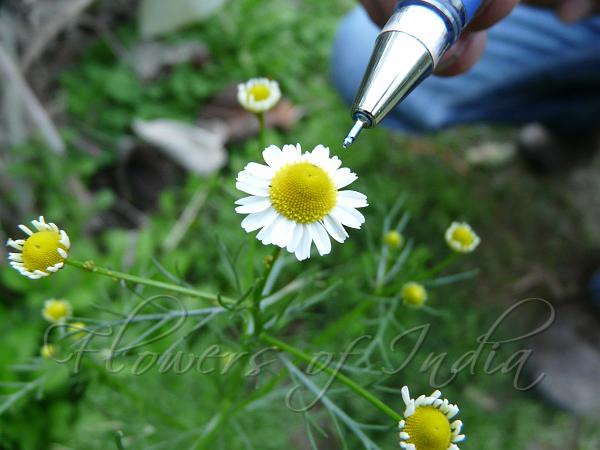|
| Chamomilla |
|

|

| File size | 2426775 |
| Original date | 2/28/10 5:43 PM |
| Resolution | 2560 x 1920 |
| Flash | Flash did not fire, auto |
| Focal length | 4.6mm |
| Exposure time | 1/30s |
| Aperture | 2.8 |
| Focus Distance | |
| Metering Mode | Multi-segment |
| Camera make | Panasonic |
| Camera model | DMC-FZ18 |
| Sensor type | OneChipColorArea |
|
|
|
|
Photo: |
Botanical name: Matricaria chamomilla Family: Asteraceae (Sunflower family)
Synonyms: Chamomilla recutita
Synonyms: Chamomilla recutita
Chamomilla is an annual herb 8–60 cm tall. The plant is aromatic when
bruised. Stems are erect or rising, branched. Leaf blades are 0.5-7.8 cm
long, very narrow, needle or thread-like. Flower-heads are daisy-like,
1-1.5 cm across, borne singly on long stalks, 2-5 cm. The central disk is
yellow and prominently convex, obovoid or spheroid to ovoid. Ray florets
are 14–26, white, 7-8.5 mm long, 2.4-3.3 mm wide. As the flower ages, the
ray florets start pointing up. Chamomilla is native to temperate Eurasia to
Indo-China, including Western Himalaya.
Medicinal uses: Chamomilla is a widely recognized herb in
Western culture. Its medicinal usage dates back to antiquity where such
notahles as Hippocrates, Galen, and Asclepius made written reference to
it. A common ingredient today in herbal teas because of its calming,
carminative, and spasmolytic properties, it is also a popular ingredient
in topical health and beauty products tor its soothing and
anti-inflammarory effects on skin.
Chamomilla is a widely recognized herb in
Western culture. Its medicinal usage dates back to antiquity where such
notahles as Hippocrates, Galen, and Asclepius made written reference to
it. A common ingredient today in herbal teas because of its calming,
carminative, and spasmolytic properties, it is also a popular ingredient
in topical health and beauty products tor its soothing and
anti-inflammarory effects on skin.
Medicinal uses:
 Chamomilla is a widely recognized herb in
Western culture. Its medicinal usage dates back to antiquity where such
notahles as Hippocrates, Galen, and Asclepius made written reference to
it. A common ingredient today in herbal teas because of its calming,
carminative, and spasmolytic properties, it is also a popular ingredient
in topical health and beauty products tor its soothing and
anti-inflammarory effects on skin.
Chamomilla is a widely recognized herb in
Western culture. Its medicinal usage dates back to antiquity where such
notahles as Hippocrates, Galen, and Asclepius made written reference to
it. A common ingredient today in herbal teas because of its calming,
carminative, and spasmolytic properties, it is also a popular ingredient
in topical health and beauty products tor its soothing and
anti-inflammarory effects on skin. | Identification credit: Tabish | Photographed in Lodhi Garden, Delhi. |
• Is this flower misidentified? If yes,